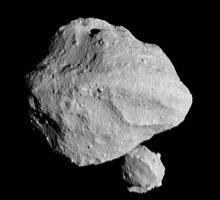Listen to today's episode of StarDate on the web the same day it airs in high-quality streaming audio without any extra ads or announcements. Choose a $8 one-month pass, or listen every day for a year for just $30.
You are here
Invaders
The aliens that invade Earth in many Hollywood blockbusters aren’t that bright. Some of them come here to take our natural resources — particularly water and metals. But Earth is a terrible place to grab those things. That’s because it takes a lot of energy to lift them away from Earth’s gravity.
If you wanted to get those same resources for cheap, the place to go would be the asteroid belt.
Astronomers have cataloged more than a half million asteroids in the belt, which lies between the orbits of Mars and Jupiter. The biggest of them is about 600 miles in diameter. And estimates say there could be a million or more that are at least a kilometer across.
Some asteroids are big chunks of iron and nickel. Others contain lots of carbon compounds. And still others are packed with silicon, magnesium, oxygen, and many other useful elements.
And many asteroids, if not most of them, contain a lot of frozen water. In fact, the largest object in the belt, Ceres, may hold more water than Earth does, hidden just below the surface. And its gravity is tiny compared to Earth’s, so it would take much less energy to carry the water away.
For a civilization capable of interstellar travel, then, it should be pretty easy to slide up next to an asteroid and start carving it apart. Even a fairly small one could provide millions of tons of raw materials, all for the taking — and without having to swat away those pesky Earthlings.
Script by Damond Benningfield






